Publication
Article
Urology Times Journal
TURP allegedly results in brain damage, death
Author(s):
Lawsuit was resolved at mediation for $3,500,000.
Acacia Brush Perko, Esq

A 65-year-old man presented to his urologist with symptoms of an enlarged prostate. He agreed to allow the urologist to perform a transurethral resection of the prostate (TURP) to remove half of the prostate. The other half of the prostate was to be removed at a later time. Prior to the TURP procedure, the urologist performed an open procedure for the removal of bladder stones. The urologist then performed the TURP procedure. After half of the enlarged prostate had been removed, a lab assessment indicated that decedent’s sodium levels were dropping. Nonetheless, the defendant proceeded to remove the other half of the enlarged prostate.
Approximately 50 minutes later, lab results reportedly showed that decedent had experienced a life-threatening decrease in sodium levels (hyponatremia) and critically elevated levels of ammonia (hyperammonemia). As a result, the patient allegedly suffered brain damage. He lapsed into a coma that lasted until his death 9 months later.
The patient’s wife brought a medical malpractice suit against the urologist, alleging that the urologist negligently performed the TURP procedure. According to the plaintiff, there is a time window of safety within which a TURP procedure can be performed with a high degree of success, both for correction of the underlying medical problem and with very little risk to the patient. However, if the TURP procedure goes longer than the window of safety, the patient is put at undue risk for several complications unique to the TURP procedure as distinct from an open prostatectomy, including dilutional hyponatremia and hyperammonemia.
The plaintiff also pointed out that the urologist determined the patient also had bladder stones and did an open procedure for removal of the stones. The plaintiff contended that extending the open procedure to remove the prostate would have been simple to do, had little to no effect on the healing time for the patient because an open procedure had already commenced, and would have avoided all the risks associated with the TURP procedure.
Still, the urologist elected to proceed with a TURP procedure after open removal of the bladder stones, according to the plaintiff. At the end of the safety window, the urologist performed a lab assessment that confirmed that the patient’s sodium was dropping. Even though the prostate was obviously greatly enlarged and was at the end of the window of safety, the urologist had removed 1 half of the prostate, and had the patient’s consent to terminate the procedure and return at a later time to compete the procedure, the urologist forged on into an allegedly unnecessary dangerous zone.
Approximately 50 to 55 minutes later, the physician drew lab values again that showed that the patient had experienced a significant and life-threatening decrease in sodium levels due to absorption of excess amounts of irrigant used in the unnecessarily prolonged TURP procedure. The patient also experienced critically elevated ammonia levels due to metabolism of the glycine irrigant.
The plaintiff alleged that her husband suffered brain damage in the course of reversal of the hyponatremia. At the time of his death, he incurred medical expenses of approximately $1,000,000. The decedent was survived by his wife, 5 adult children, and 21 grandchildren.
The defendant urologist contended that his care was within all standards of care and denied any negligence. The case proceeded through pretrial discovery, and the parties agreed to participate in private mediation. The case resolved at mediation for $3,500,000.
LEGAL PERSPECTIVE:Mediation offers parties an alternative venue for resolution outside the courtroom. There are some cases that should be tried and others that may be better suited to resolution through private negotiation or mediation. If settlement is reached at mediation, that settlement eliminates parties’ time-consuming and resource-draining participation in pretrial discovery, potential disclosure of personal and proprietary information, commitment of personal time, ongoing legal fees and expenses, unpredictability of verdict and judgment at trial, and unpredictability of appellate review of trial. Alternatively, mediation and settlement offers immediate conclusion and terms of resolution, which are unavailable through court. In this instance, mediation allowed the parties finality and closure.

Newsletter
Stay current with the latest urology news and practice-changing insights — sign up now for the essential updates every urologist needs.































